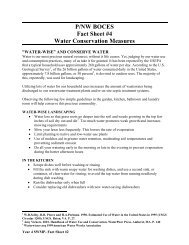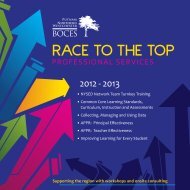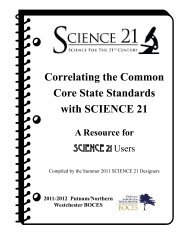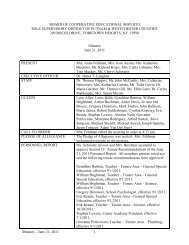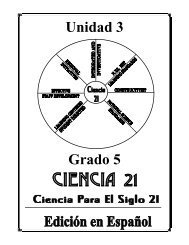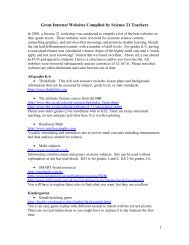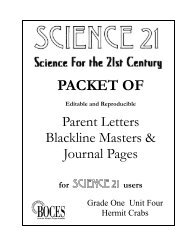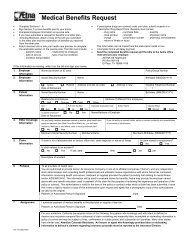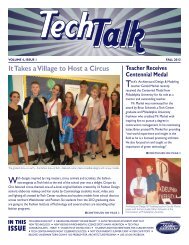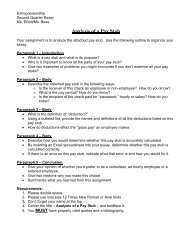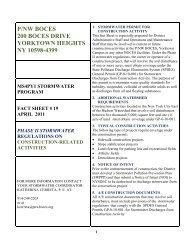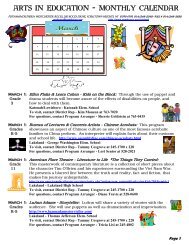SCIENCE 21 CURRICULUM MAP - Boces
SCIENCE 21 CURRICULUM MAP - Boces
SCIENCE 21 CURRICULUM MAP - Boces
Create successful ePaper yourself
Turn your PDF publications into a flip-book with our unique Google optimized e-Paper software.
<strong>SCIENCE</strong> <strong>21</strong> <strong>CURRICULUM</strong> <strong>MAP</strong><br />
Grade Level: 5<br />
Essential Questions for Grade Level:<br />
• How do scientists use tools to observe, describe, and measure the interactions they find in the natural world?<br />
• How does matter interact with other matter?<br />
• What are cells in living organisms and how do they help an organism survive?<br />
• How are the internal systems of organisms structured to help an organism survive?<br />
• What forms of energy do we find in our world and how does that energy interact with matter?<br />
Unit/Timeframe Unit Essential Unit Concepts/Major NYS Performance<br />
Questions Objectives Understandings Indicators<br />
Unit 1:<br />
Interactions of<br />
Chemical<br />
Matter<br />
September. –<br />
mid-October<br />
• What is a<br />
“fair” test?<br />
• How can we<br />
be safe<br />
when we<br />
investigate?<br />
• What is<br />
matter?<br />
• How do<br />
elements<br />
react with<br />
one another?<br />
• How do<br />
substances<br />
react with<br />
one another?<br />
Students will be able to investigate<br />
interactions in the natural world using<br />
controlled studies.<br />
1. Be able to summarize the steps of the<br />
scientific method.<br />
2. Be able to engage in the process of<br />
science that includes observing,<br />
questioning, predicting, hypothesizing,<br />
conducting investigations, analyzing data<br />
and communicating their findings in a<br />
variety of ways.<br />
3. Be able to define and describe what<br />
variables are (controlled, manipulated,<br />
dependent).<br />
4. Be able to design a controlled study and<br />
use that model for an investigation.<br />
5. Be able to develop and carry out a<br />
controlled study.<br />
6. Be able to observe, describe and record<br />
the properties of materials using<br />
controlled studies.<br />
7. Be able to make connections to realworld<br />
implications and uses of the<br />
compound, “sodium polyacrylate”.<br />
N:\Science <strong>21</strong>\Misc\Curriculum Maps\Sci <strong>21</strong> Maps\5th Grade Maps\Grade 5 Unit 1.doc<br />
• The process of scientific inquiry<br />
includes observing natural phenomena,<br />
conducting controlled experiments to<br />
test hypotheses, gathering evidence and<br />
analyzing data, constructing<br />
explanations, and presenting the findings<br />
to others.<br />
• In a controlled experiment, the effect of<br />
changes in the manipulated variable<br />
(independent variable) on another<br />
variable (dependent variable) is<br />
measured. The investigator must<br />
identify all the other possible variables<br />
that can affect the manipulated variable<br />
and design an experiment in which these<br />
are kept constant.<br />
• The decrease in viscosity of a polymer<br />
upon addition of water can be<br />
investigated using a controlled study.<br />
• Atoms are the smallest particles of a<br />
chemical element and molecules are the<br />
smallest particles of a compound.<br />
Elements combine in many ways to<br />
produce compounds.<br />
SI 2.1A<br />
SI 2.3A<br />
SI 2.3<br />
SI 2.2A-C<br />
SI 2.2A-C<br />
SI 2.2A-C<br />
SI1.2 A-C
<strong>SCIENCE</strong> <strong>21</strong> <strong>CURRICULUM</strong> <strong>MAP</strong><br />
Grade Level: 5<br />
Essential Questions for Grade Level:<br />
• How do scientists use tools to observe, describe, and measure the interactions they find in the natural world?<br />
• How does matter interact with other matter?<br />
• What are cells in living organisms and how do they help an organism survive?<br />
• How are the internal systems of organisms structured to help an organism survive?<br />
• What forms of energy do we find in our world and how does that energy interact with matter?<br />
Unit/Timeframe Unit Essential Unit Concepts/Major NYS Performance<br />
Questions Objectives Understandings Indicators<br />
Unit 2:<br />
Interactions in<br />
the<br />
Microworld<br />
Mid-October-<br />
December<br />
• What are<br />
cells and how<br />
do they carry<br />
out life<br />
functions?<br />
• How are cells<br />
organized<br />
into working<br />
groups?<br />
• How are<br />
organisms<br />
grouped and<br />
classified?<br />
• How do<br />
living<br />
organisms get<br />
the energy<br />
they need and<br />
how do they<br />
use it?<br />
Students will be able to explore<br />
interactions in the microworld.<br />
1. Be able to use magnifying tools to<br />
study living and non-living things.<br />
2. Be able to determine the differences<br />
between living and non-living things.<br />
3. Be able to use a taxonomic key to<br />
identify organisms.<br />
4. Be able to determine the differences<br />
between plant and animal cells.<br />
5. Be able to identify and list the<br />
functions of cell parts.<br />
6. Be able to compare organisms in<br />
terms of systems, organs, tissues and<br />
cells.<br />
7. Be able to develop an explanation of<br />
how cells function to enable an<br />
organism to survive.<br />
8. Be able to explore how the survival<br />
of a cell or organism may impact its<br />
environment and possibly the life<br />
and environment of another<br />
organism.<br />
N:\Science <strong>21</strong>\Misc\Curriculum Maps\Sci <strong>21</strong> Maps\5th Grade Maps\Grade 5 Unit 2.doc<br />
• The cell theory is a well-tested and accepted<br />
explanation of the relationship between cells and living<br />
things. It states that all living things are composed of<br />
one or more cells, that the cell is the smallest unit<br />
having the properties of life, and that all cells are<br />
produced from the growth and division of single cells.<br />
• Cells, and some living organisms, are too small to see<br />
without a microscope. When magnified, observable<br />
structures can be seen in all cells. These structures<br />
enable the cell to perform basic functions of life.<br />
• Cells grow and divide, producing more cells for growth<br />
and repair. One-celled organisms reproduce by cell<br />
division.<br />
• Scientists use a classification system to organize living<br />
things into groups based on important biological<br />
similarities, so that they are easier to study. Organisms<br />
are classified into seven levels, from kingdom (most<br />
general) to species (most specific).<br />
• Multicellular organisms have specialized cells, with<br />
different shapes and sizes, to carry out the functions of<br />
the organism; groups of specialized cells form tissue,<br />
groups of tissue form organs, and organs working<br />
together form organ systems.<br />
• If there is a failure in a structure or in the functioning of<br />
an organism, or if the organism is damaged by infection<br />
from another organism, the result is disease.<br />
LE 1.1<br />
LE 1.1<br />
LE 1.1 A,B<br />
LE 1.1A-H<br />
LE 4.4A<br />
LE 4.4B<br />
LE 4.4B,C,D<br />
LE 4.4A-H
<strong>SCIENCE</strong> <strong>21</strong> <strong>CURRICULUM</strong> <strong>MAP</strong><br />
Grade Level: 5<br />
Essential Questions for Grade Level:<br />
• How do scientists use tools to observe, describe, and measure the interactions they find in the natural world?<br />
• How does matter interact with other matter?<br />
• What are cells in living organisms and how do they help an organism survive?<br />
• How are the internal systems of organisms structured to help an organism survive?<br />
• What forms of energy do we find in our world and how does that energy interact with matter?<br />
Unit/Timeframe Unit Essential Unit Concepts/Major NYS Performance<br />
Questions Objectives Understandings Indicators<br />
Unit 3:<br />
Interactions<br />
in the<br />
Human<br />
Body<br />
January –<br />
Mid-March<br />
• How do<br />
organs and<br />
tissues<br />
interact with<br />
one another<br />
and carry out<br />
life<br />
functions?<br />
• How do<br />
organ<br />
systems work<br />
and respond<br />
to changing<br />
demands of<br />
an organism?<br />
• How are<br />
traits in<br />
organisms<br />
passed from<br />
one<br />
generation to<br />
another?<br />
• How do we<br />
keep our<br />
bodies<br />
healthy?<br />
Students will be able to explore<br />
interactions in the human body.<br />
1. Be able to analyze how a simple<br />
human activity illustrates the<br />
overlapping functions of both the<br />
respiratory and circulatory systems.<br />
2. Be able to determine the role and parts<br />
of the human respiratory system.<br />
3. Be able to determine the role and parts<br />
of the human circulatory system.<br />
4. Be able to investigate how the<br />
respiratory and circulatory systems<br />
interact.<br />
5. Be able to analyze how a simple<br />
human activity illustrates the<br />
overlapping functions of both the<br />
muscular and skeletal systems.<br />
6. Be able to determine the role and parts<br />
of the human muscular system.<br />
7. Be able to determine the role and parts<br />
of the human skeletal system.<br />
8. Be able to investigate how the<br />
muscular and skeletal systems interact.<br />
9. Be able to explore how human<br />
inheritance operates and investigate the<br />
role of genetics in our life.<br />
N:\Science <strong>21</strong>\Misc\Curriculum Maps\Sci <strong>21</strong> Maps\5th Grade Maps\Grade 5 Unit 3.doc<br />
• Humans have organ systems to carry out functions such as<br />
respiration, circulation, movement, control and coordination. These<br />
organ systems interact with each other to serve the organism as a<br />
whole.<br />
• The tissues and organs of the respiratory system take in oxygen and<br />
deliver it to the blood. The respiratory system works together with<br />
the heart, blood vessels and blood of the circulatory system to<br />
provide oxygen to every cell in the body and to remove carbon<br />
dioxide and water, the end products of cellular respiration.<br />
• Interaction between the skeletal system and the muscular system<br />
enables movement of the body. This interaction is coordinated by<br />
the nervous system.<br />
• Heredity is the passage of instructions for specifying traits of an<br />
organism from parents to offspring. Genes are the units of<br />
information about heritable traits, and each gene has a particular<br />
location on a particular chromosome. All of the heritable bits of<br />
information that are necessary to produce a new individual are<br />
carried by the DNA molecules that make up the genes.<br />
• Genes occur in pairs and offspring inherit one copy of each gene<br />
from each parent. A gene is dominant when its effect on a trait<br />
overshadows that of the other gene (recessive) paired with it. This is<br />
Mendel’s Law of Dominance.<br />
• Punnett squares help to visualize the possible outcomes for<br />
inheritance of a trait and can be used to determine the probability of<br />
a particular outcome for a trait that is controlled by a single gene.<br />
Pedigree charts can track the inheritance of traits from generation to<br />
generation.<br />
• Biological adaptations are heritable traits that arise from mutations<br />
and help an organism survive and reproduce.<br />
LE 1.2D,F<br />
LE 1.2A,<br />
B,D,F<br />
LE 1.2A,B,C,F<br />
LE 1.2 A<br />
LE 1.2 A-G<br />
LE 1.2A<br />
LE 1.2 A-G<br />
LE 2.2A<br />
LE 2.2C
<strong>SCIENCE</strong> <strong>21</strong> <strong>CURRICULUM</strong> <strong>MAP</strong><br />
Grade Level: 5<br />
Essential Questions for Grade Level:<br />
• How do scientists use tools to observe, describe, and measure the interactions they find in the natural world?<br />
• How does matter interact with other matter?<br />
• What are cells in living organisms and how do they help an organism survive?<br />
• How are the internal systems of organisms structured to help an organism survive?<br />
• What forms of energy do we find in our world and how does that energy interact with matter?<br />
Unit/Timeframe Unit Essential Unit Concepts/Major NYS Performance<br />
Questions Objectives Understandings Indicators<br />
Unit 4:<br />
Interactions<br />
in the<br />
Environment<br />
Mid-March<br />
–<br />
June<br />
• How does<br />
matter move<br />
and change in<br />
the<br />
environment?<br />
• How is<br />
energy<br />
transferred<br />
and<br />
transformed<br />
as it flows<br />
through a<br />
food chain?<br />
• How do<br />
meteorologist<br />
s organize<br />
and use<br />
information<br />
about air,<br />
water, and<br />
land to<br />
predict the<br />
weather?<br />
Students will be able to investigate interactions<br />
in the environment.<br />
1. Be able to identify the characteristics of a<br />
physical change and a chemical change.<br />
2. Be able to investigate chemical reactions and<br />
how photosynthesis (as a chemical reaction) is<br />
so crucial to all living things.<br />
3. Be able to investigate how energy transfer in the<br />
environment is necessary for plants to grow and<br />
develop.<br />
4. Be able to explore the energy transfers that<br />
occur in weather systems.<br />
5. Be able to draw relationships between weather<br />
and climate factors and the characteristics of an<br />
ecosystem.<br />
6. Be able to identify the characteristics of their<br />
own local ecosystem and relate them to larger<br />
ecosystems.<br />
7. Be able to research the role of energy transfer on<br />
ecosystems, on a global scale.<br />
• In physical changes, substances retain their<br />
characteristic properties, while in chemical<br />
changes, new substances are formed; in all<br />
changes, mass and energy are conserved.<br />
• During photosynthesis, green plants use energy<br />
from the Sun to convert carbon dioxide and<br />
water into sugar and oxygen. The stored<br />
chemical energy in sugar is then transformed<br />
by plants into all the products they need for<br />
growth and metabolism; the oxygen is used by<br />
all organisms for cellular respiration.<br />
• Animals cannot make their own food and they<br />
get the food they need by eating plants or by<br />
eating other animals that have eaten plants; the<br />
energy from the food is used for all their life<br />
processes.<br />
• Model ecosystems, consisting of populations<br />
of several species in their suitable habitats,<br />
help us to observe the complex relationships<br />
between living organisms and their<br />
environment and they illustrate the flow of<br />
energy between plants and animals.<br />
PS 4.3A<br />
LE 6.2a-c<br />
LE 6.1A-C<br />
PS 2.2A, B<br />
PS 2.1A-C<br />
PS 2.2A-C<br />
PS 4.2A<br />
N:\Science <strong>21</strong>\Misc\Curriculum Maps\Sci <strong>21</strong> Maps\5th Grade Maps\Grade 5 Unit 4.doc



